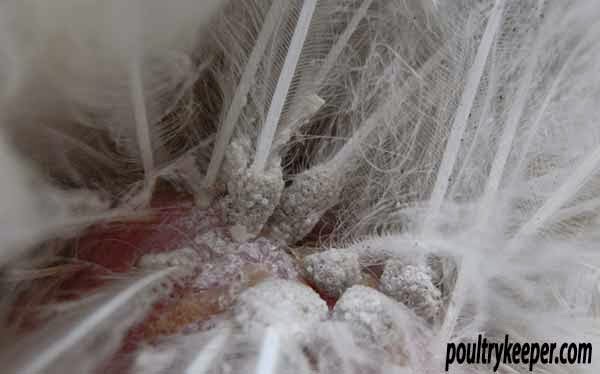
Thankfully, it immediately killed the lice, however, I retreated with DE a week later (because more lice had hatched) and DE did the job just fine with zero chemicals and absolutely no reaction. I completely understand there is a DE debate on whether it is safe or not, but when used wisely, it works wonders, and my own body thanked me afterwards as well.
 |
| Lice eggs — Photo via poultrykeeper.com |
1. Examine all chickens. Lice will be visible on the skin of the belly and around the vent. They will be nasty and crawling quickly, so look thoroughly. Assume that all of your flock could potentially have lice or lice eggs on them. Lice eggs will be seen (pictured above) at the base and on the shaft of the feather. Separate chickens that look anemic or lethargic from the rest of the flock. For chickens that visibly have lice on them, dust (to the skin) cautiously with food grade Diatomaceous Earth (DE). Wood ash is a more natural option if you are against DE. However, DE works just fine on our homestead and we have absolutely zero issues using it.
2. Create a large bathing area for your chickens if you do not already have one. Fill it with fresh wood ash. Wood ash is a completely all natural way to rid chickens of lice and mites. In fact, you can even rub your chickens down (to the skin) with wood ash and a little dusty dirt rather than using DE. It will naturally kill mites and lice. Make sure there is plenty of wood ash in the dust bathing area for the next 4 weeks.
3. Thoroughly clean out coop and give a good layer of DE to the entire coop, including roosts and nesting boxes. Do not put bedding down for 1 hour. Do not allow your chickens back into the coop for 2 hours so that the dust settles. Lock them in their run or allow them to free range without coop access for 2 hours, total.
I hope that my horrible experience can help many of you. I doubt we will ever have to deal with this again, as we are completely on top of things now and will give any new hens brought in a thorough run down. However, sometimes life just throws you lemons — and it is better to be prepared now than when you actually need the reference!
As always, the key is prevention — weekly check overs, quarantining new chickens, a clean coop and living area, and good diets are important!
On our homestead, we strive to treat as naturally as possible. Certainly, there are some dire instances when less natural remedies must be used. However, thankfully, we have not had to use anything other than all natural treatments for quite some time now.
With that said, if you find that this natural remedy is just too much, or your chickens aren’t progressing, the chemical fix is simple and can be used as a last resort. Don’t beat yourself up about it!! Use 2-3 drops of Eprinex or Ivermectin on the skin of the back of the chickens neck. Just keep in mind there is a withdrawal period of 2 weeks after treating, and you’ll probably have to treat once a week for 2-4 weeks.






Yes, using wood ash in every aspect of your chickens daily needs will increase its output exponentially, I got proof.
This is exactly what I was hoping I’d get when I googled natural lice remedies for poultry – thank you so much! My chickens thank you too.
x